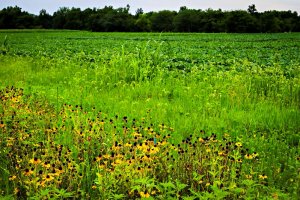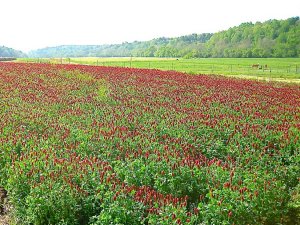AgEBB-MU CAFNR Extension
Green Horizons
Spring 2022
Creating Inviting Pollinator Habitats in Agriculture
Authored by Kelly R. Wilson and Robert L. Myers
Importance of Pollinators to Agriculture
Pollinators play essential ecosystem services for both wild plant communities and agricultural production (Klein et al., 2007; Ricketts et al., 2008). Beneficial insects, such as bees, butterflies, beetles, moths, wasps, and flies, as well as certain species of birds and bats, contribute to the productivity of more than 100 crops grown in the United States. Unfortunately, we have seen significant declines in key pollinator species since at least the late 20th century, due in part to the agricultural practices that have reduced plant diversity and pollinator habitat (Nicholls & Altieri, 2013; Vanbergen et al., 2020). Intensified agricultural systems, such as extensive fields with only one or two crops, have very little floral diversity (Vanbergen & Initiative, 2013). Without pollen and nectar resources and nesting habitats, the quantity and diversity of pollinators are reduced or even eliminated from the land (Nicholls & Altieri, 2013). Removal of weeds, use of insecticides, and the spread of invasive insect diseases further contribute to the decline of pollinator habitats and populations globally (Nicholls & Altieri, 2013; Vanbergen & Initiative, 2013).
Fortunately, there is a growing body of research that demonstrates how farmers and landowners can restore plant bio-diversity to generate inviting habitats for essential pollinators, therefore increasing pollination services (Nicholls & Alteri, 2005; Nicholls & Altieri, 2013). In addition, there are several opportunities to receive support to help you implement practices to improve pollinator habitats on their land.
Strategies to Increase Pollinator Abundance in Crop Fields
 |
| Hedgerow habitat planted alongside soybean-corn rotated field comprised of native wilflowers |
Maintain uncultivated land along the perimeters of your fields
Create hedgerow habitat along the parameters of your cultivated fields using native and flowering plants. These will provide nesting sites and floral resources for wild bees and will bring more pollinators from natural areas to your fields. To benefit your insect-pollinated crop, their habitat should be within a half-mile of the crop - but the closer the nesting site is to the crop the more bees will be able to reach it in bloom (Vaughan et al., 2007).
Develop year-round bee pastures
Bee pastures are land that purposefully integrates plants conducive for maximum bee reproduction. A successful bee pasture will include plants that bloom throughout the nesting period (from early spring through late fall) and have dense wildflower meadows comprised of different plant species. The more pollinator habitat available the better, but bee pastures do not need to be large! Planting a few strips of one acre size near the edge of crops can help provide needed habitat to bees.
Most wild bees nest in the ground, so avoid farming practices such as excessive plastic mulching and extensive tillage as they can inhibit or destroy nests.
Manage wildflower growth within fields and in field borders
When creating hedgerow habitats, choose plants that bloom before and after the cash crop flowers and avoid plants that might become hosts for harmful pests or that may compete with your primary crop. Some useful plant species are buckwheat, poppy and many ragweed species, and flowering plants from the Umbelliferae and Compositae families. You can buy seed mixtures designed specifically to attract bees and other pollinators or create your own mix!
To sustain bee populations in orchards, choose flowering groundcover species that produce plenty of nectar and pollen but flower before and after the fruit crops. Perennial covers crops that enable bees to nest in the ground are good options for this. Some examples are red and white clover, various vetches, and native wildflowers.
Minimize tillage and herbicide application to encourage pollinator habitats to develop, as these practices can eliminate or reduce numbers of pollinators that are attracted by wildflowers before, during, and after the main crop flowers.
Choose the right plants to maximize pollinator diversity
To develop pollinator habitats that attract a diversity of pollinators throughout the year, use a diversity of flowering plants using the following recommendations:
- Choose 15 or more flowering plant species, ensuring that at least three are in bloom at any given time during the growing season.
- Use combinations of annuals and perennials.
- To attract different pollinators, use a variety of flower colors and shapes.
- Encourage plants to grow in clumps as opposed to single plants.
- Maintain weed and floral diversity as intermittent strips between crop rows or mixed into the field parameters.
- When possible, establish native plants, including wildflowers and flowering shrubs. These will attract more wild pollinators and can serve as larval host plants for some pollinator species.
To learn more about what pollinator plants will work for you, check out this site! You can enter in your zip code to get resources specific to your area.
 |
| Crimson clover planted as cover crop can improve soil health and attract pollinators, like bees |
Integrate flowering crops in your crop rotation
Legume cover crops are not only good green manure or cover crops to work into your rotations, but they also are a food source for pollinators (LaRose & Myers, 2019; Lee-Mader et al., 2020). Examples of cover crops that attract bees include hairy vetch and crimson clover, and non-legumes such as sunflowers and buckwheat. Flowering cash crops like canola can also help to attract pollinators.
Use intercropping to attract a diversity of pollinator species
Intercropping systems can be an effective strategy for providing habitats for pollinating insects within your fields. Plant tall and short crops together, such as corn and beans.
Support and resources for improving pollinator habitats on your land
There are several programs to help transform your land into a pollinator haven. Here are a few opportunities to explore:
Environmental Quality Incentives Program (EQIP)
EQIP is offered through USDA's Natural Resources Conservation Service (NRCS). This program provides financial and technical assistance to farmers and landowners to address a range of natural resource issues and to produce environmental benefits. Learn more about EQIP here and contact your local NRCS office to see if EQIP is a good fit for you and for guidance on how to apply.
Conservation Reserve Program (CRP)
CRP is a land conservation program coordinated by USDA's Farm Service Agency (FSA). The program offers annual rental payment and cost-share assistance to farmers enrolled in the program who agree to preserve environmentally sensitive land for plant species that enhance environmental health and quality instead of agricultural crops. Learn more about CRP here and contact your local FSA office for more information about the CRP program and see if you are eligible.
Emergency Assistance for Livestock, Honeybees, and Farm-raised Fish Program (ELAP)
FSA also offers emergency assistance for honeybee, as well as livestock and farm-raised fish producers through the ELAP program. ELAP provides financial assistance to producers experiencing honeybee losses from their hives for honey production, pollination, or honeybee breeding due to disease and certain adverse weather events. Learn more about ELAP here and contact your your local FSA office for more information on how to apply.
Become a Bee Better Certified producer!
The Xerces Society established the Bee Better Certification to promote pollinator conservation in agriculture. The Bee Better production standards are based on scientific evidence and have been fieldtested to ensure that action farmers take actually improve pollinator well-being. You can learn about Bee Better Certification here: https://beebettercertified.org/.
References
Klein, A.-M., Vaissiere, B. E., Cane, J. H., Steffan-Dewenter, I., Cunningham, S. A., Kremen, C., & Tscharntke, T. (2007). Importance of pollinators in changing landscapes for world crops. Proceedings of the Royal Society B: Biological Sciences, 274(1608), 303-313.
LaRose, J., & Myers, R. (2019). Cover Crop Impacts on Pollinators (Cover Crop Resource Series). Sustainable Agriculture Research & Education (SARE). http://www.sare.org/covercrops-pollinators.
Lee-Mader, E., Stine, A., Fowler, J., Hopwood, J., & Vaughan, M. (2020). Cover Cropping for Pollinators and Beneficial Insects. Xerces Society for Invertebrate Conservation & Sustainable Agriculture Research & Education (SARE). https://www.sare.org/resources/cover-cropping-forpollinators-and-beneficial-insects/.
Nicholls, C. I., & Alteri, M. A. (2005). Agroecological Strategies to Enhance On-Farm Insect Pollinators. In M. A. Alteri, C. I. Nicholls, & M. A. Fritz (Eds.), Managing insects on your farm: A guide to Ecological Strategies (pp. 110-118). Sustainable Agriculture Research and Education (SARE).
Nicholls, C. I., & Altieri, M. A. (2013). Plant biodiversity enhances bees and other insect pollinators in agroecosystems. A review. Agronomy for Sustainable Development, 33(2), 257-274.
Ricketts, T. H., Regetz, J., Steffan-Dewenter, I., Cunningham, S. A., Kremen, C., Bogdanski, A., Gemmill-Herren, B., Greenleaf, S. S., Klein, A. M., & Mayfield, M. M. (2008). Landscape effects on crop pollination services: Are there general patterns? Ecology Letters, 11(5), 499-515.
Vanbergen, A. J., Aizen, M. A., Cordeau, S., Garibaldi, L. A., Garratt, M. P., Kovács-Hostyánszki, A., Lecuyer, L., Ngo, H. T., Potts, S. G., & Settele, J. (2020). Transformation of agricultural landscapes in the Anthropocene: Nature's contributions to people, agriculture and food security. Advances in Ecological Research, 63, 193-253.
Vanbergen, A. J., & Initiative, the I. P. (2013). Threats to an ecosystem service: Pressures on pollinators. Frontiers in Ecology and the Environment, 11(5), 251-259.
Vaughan, M., Shepherd, M., Kremen, C., & Black, S. H. (2007). Farming for bees: Guidelines for providing native bee habitat on farms. Xerces Society.
This publication was supported by a grant from the Missouri Department of Conservation.
| Visit cra.missouri.edu for more resources. |
 |
